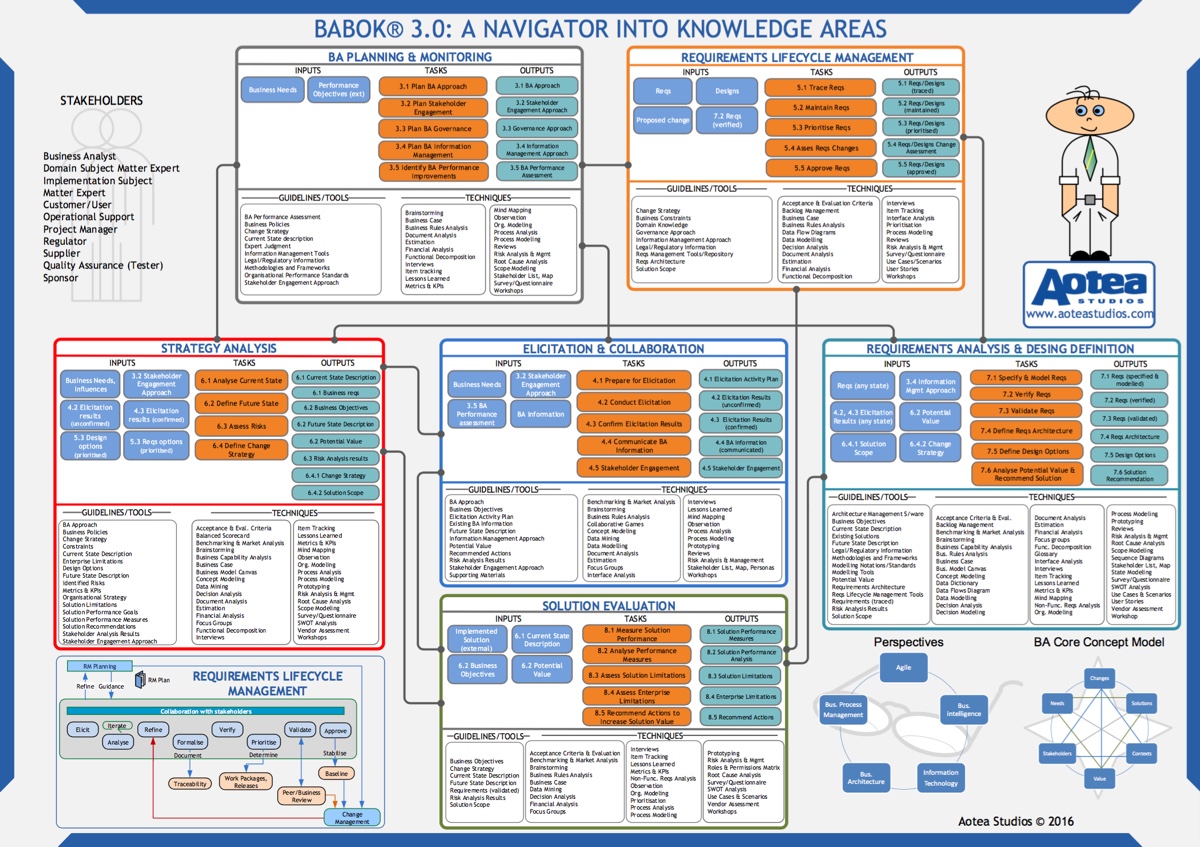BABOK 3.0: Overview of the latest edition
A year ago, on April 15, 2015, the International Institute of Business Analysis (IIBA) officially issued the long awaited Business Analysis Book of Knowledge version 3 (BABOK V3). Here is my overview of the changes from the previous version.
Don’t miss the poster at the end - it provides a single page overview of the BABOK.
First impressions
After flipping through the chapters, I noted to myself that there are several improvements to the previous version, 2.0. Here is what drew my attention:
Changes in used terminology
The language of the Body has become more academic and harder to read and grasp. And I assume re-certification of CBAPs will become a bit harder due to this change, too.
Introduction of BA Core Concept Model
The model covers the following core concepts:
- change to the current state
- need to be satisfied (and thus requiring a change to the status quo)
- solution to satisfy the identified need
- stakeholders related to the change
- value to stakeholders as a result of the undertaken change.
Several viewpoints called Perspectives
The following Perspectives are included in the latest version:
- Agile - focuses on a tighter collaboration and completing the task at the last moment to allow flexible acceptance of a change
- Business Intelligence - focuses on business data and everything around data: sources, interfaces, decision points, data views, the use of the data at the executive, management and process levels.
- Information Technology - focuses on assessing the impact of a change on the information systems of an enterprise.
- Business Architecture - focuses on alignment of tactical transformational efforts with strategic objectives of the stakeholders and the enterprise.
- Business Process Management - focuses on the value delivery chain for stakeholders and customers of the enterprise and applies a process centric viewpoint.
Changes to naming of Knowledge Areas
The only chapter without the name change is BA Planning and Monitoring. All other Knowledge Areas were renamed in the following manner:
- Requirements Elicitation -> Elicitation and Collaboration
- Requirements Management and Communication -> Requirements Lifecycle
- Enterprise Analysis -> Strategy Analysis
- Requirements Analysis -> Requirements Analysis and Design Definition
- Solution Assessment and Evaluation -> Solution Evaluation.
Introduction of a new term: Requirements Architecture
This is the most confusing part of the new version to me. When working on a project (regardless of methodology), a BA takes into account any stated requirements, organisational standards and the defined solution scope. As an output, the BA prepares requirements packages suitable to different audiences of stakeholders. As you see, the essence of the performed activities is clearly defined by the previously used name of the Knowledge Area - Requirements Management and Communication. The new name is not as clear.
Changes to the list of techniques
Quite a few techniques were added from the Agile extension to the previous version. These techniques are:
- Backlog Management
- Balanced Scorecard
- Business Capability Analysis
- Collaborative Games
Two more tasks were added from the Agile extension:
- Decision Modelling
- Roles and Permissions Matrix.
Clear presentation of transition requirements
The latest version higlights the importance of transition requirements, in contrast to the old version. In the past, transition requirements were not considered a focus for a BA where a new solution was implemented. The premise was that there is no “transition” to the new solution. It’s good to see that this premise is discarded in the new edition.
BABOK overview poster
Back when we started the blog, we published a poster on BABOK 2.0. Today, I’m glad to share the new poster - a practical overview of the BABOK 3.0. The poster illustrates the key knowledge areas, tasks, their inputs and outputs, concept models and, of course, the techniques recommended for the use within each Knowledge Area:
Until next time!

New! We have published a new book: A Navigator to Business Analysis.
Over 400 pages of practical, useful material will help you build your skills and advance your career! Find out more and get free excerpt.
Free course: BABOK 3 Navigation Maps
Subscribe and get an overview of the knowledge areas in BABOK 3. (Very occasionally, we may let you know about discounts and specials).
